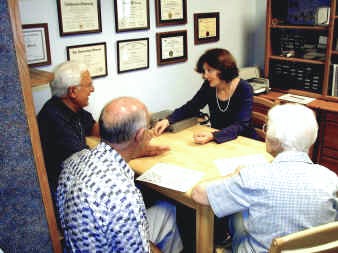|

Michele Wilson, Ph.D., educating patients in her
Irvine office.
- Speak in a normal tone of voice. Do not shout.
Shouting distorts the sound of your voice.
- Speak clearly and slowly. Don't clip word endings or mumble, and don't over-articulate your words. Stress key words and pause between statements.
- Use natural gestures and natural facial expressions. Avoid moving around while you talk.
- Speak at a distance of between three and six feet. Don't make the hearing-impaired person speech-read over excessive distances.
- Stand in clear
light facing the person with whom you are speaking. This will make your
lip movements, facial expressions, and gestures easier to see.
- Make sure you have the hearing-impaired person's attention and are clearly visible to him or her before you start speaking. Tapping the person on the shoulder or waving from a distance are acceptable methods for getting the person's attention.
- Move away from background noise.
- Rephrase what you have said when you think the hearing impaired person has misunderstood you. Look for clues, like facial expressions and inappropriate responses. Do not assume that you must restate everything, though.
- Do not obscure your mouth or chew food while speaking.
- Include the hearing-impaired person in the conversation. Tell the person the topic of conversation; don't force him or her to guess. Speak directly to, not about, the
hearing-impaired person.
- In meetings or group activities where there is a speaker, suggest that the speaker use the public address system.
- Arrange the room where communication will take place so that all the participants are completely visible to one another. Try to eliminate or diminish background noise.
- Ask the hearing-impaired person what you can do to make conversation easier.
|
|